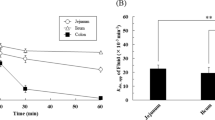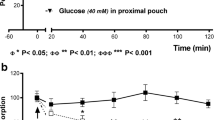Abstract
The effects of lumenal glucose on jejunal water transport and the influence of glucose-induced water absorption on solute uptake from single-pass perfusions are compared in anesthetized rats in situ and isolated chronic loops in unanesthetized rats in vivo. While the magnitudes of solute membrane permeabilities are consistently higher in the chronic loop system, the effects on water transport and its promotion of jejunal solute uptake are comparable between the two experimental systems. The effect of glucose-induced water absorption on the enhanced/baseline jejunal uptake ratio of the hydrophilic drug, acetaminophen, is greater than that for the lipophilic drug, phenytoin, in both experimental systems. The fact that chronic loop effective solute permeabilities were equivalent to solute membrane permeabilities in situ is consistent with greater lumenal fluid mixing in vivo. In addition, in situ body temperature affects the uptake of phenytoin but not acetaminophen, water, or glucose. This suggests that active and paracellular solute transport is not compromised in situ, while membrane partitioning and diffusion of lipophilic species are more sensitive to experimental conditions.
Similar content being viewed by others
REFERENCES
S. Shanker, D. J. Tocco, B. B. Brodie, and C. A. M. Hogben. Absorption of drugs from the rat small intestine. J. Pharmacol. Exp. Ther. 123:81–88 (1958).
N. Schurgers, J. Bijdendijk, J. J. Tukker, and D. J. A. Crommelin. Comparison of four experimental techniques for studying drug absorption kinetics in the anesthetized rats in situ. J. Pharm. Sci. 75:117–119 (1986).
G. L. Amidon, J. H. Kou, R. L. Elliott, and E. N. Lightfoot. Analysis of models for determining intestinal wall permeabilities. J. Pharm. Sci. 69:1369–1373 (1980).
I. Komiya, J. Y. Park, A. Kamani, N. F. H. Ho, and W. I. Higuchi. Physical model studies on the simultaneous fluid flow and absorption of steroids in the rat intestines. Int. J. Pharm. 4:249–262 (1980).
H. H. Lu, J. D. Thomas, and D. Fleisher. The influence of D-glucose-induced water absorption on rat jejunal uptake of two passively absorbed drugs. J. Pharm. Sci. 81:21–25 (1992).
G. L. Amidon, P. S. Sinko, and D. Fleisher. Estimating human oral fraction dose absorbed: A correlation using rat intestinal membrane permeability for passive and carrier-mediated compounds. Pharm. Res. 5:651–654 (1988).
F. G. J. Poelma and J. J. Tukker. Evaluation of a chronically isolated loop in the rat for the study of drug absorption kinetics. J. Pharm. Sci. 76:433–436 (1987).
R. A. Wapnir and F. Lifshitz. Osmolality and solute concentration: their relationship with oral hydration solution effectiveness: An experimental assessment. Pediat. Res. 19:894–898 (1985).
K. L. Meadows. The Intestinal Uptake of Purine Bases and Analogues, Ph.D. thesis, University of Michigan, Ann Arbor, 1988.
I. S. Menzies, A. P. Jenkins, E. Heduan, S. D. Catt, M. B. Segal, and B. Creamer. The effect of a poorly absorbed solute on intestinal absorption. Scand. J. Gastroenterol. 25:1257–1264 (1990).
J. H. Kou, D. Fleisher, and G. L. Amidon. Calculation of the aqueous diffusion layer resistance for absorption in a tube: Application to intestinal membrane permeability determination. Pharm. Res. 8:298–305 (1991).
D. Fleisher, N. Sheth, H. Griffin, M. Mcfadden, and G. Aspacher. Nutrient influences on intestinal phenytoin uptake. Pharm. Res. 6:332–337 (1989).
D. Winne and J. Remischovsky. Intestinal blood flow and absorption of non-dissociable substances. J. Pharm. Pharmacol. 22:640–641 (1970).
M. J. McCann and E. M. Strieker. Gastric emptying of glucose loads in rats: Effects of insulin-induced hypoglycemia. Am. J. Physiol. 251:R609–R613 (1986).
H. Yuasa, T. Iga, M. Hanano, and J. Watanabe. Comparative assessment of the resistance of the unstirred water layer to solute transport between two different intestinal perfusion systems. Biochim. Biophys. Acta. 928:189–198 (1988).
Author information
Authors and Affiliations
Rights and permissions
About this article
Cite this article
Lu, HH., Thomas, J.D., Tukker, J.J. et al. Intestinal Water and Solute Absorption Studies: Comparison of in Situ Perfusion with Chronic Isolated Loops in Rats. Pharm Res 9, 894–900 (1992). https://doi.org/10.1023/A:1015848815616
Issue Date:
DOI: https://doi.org/10.1023/A:1015848815616




